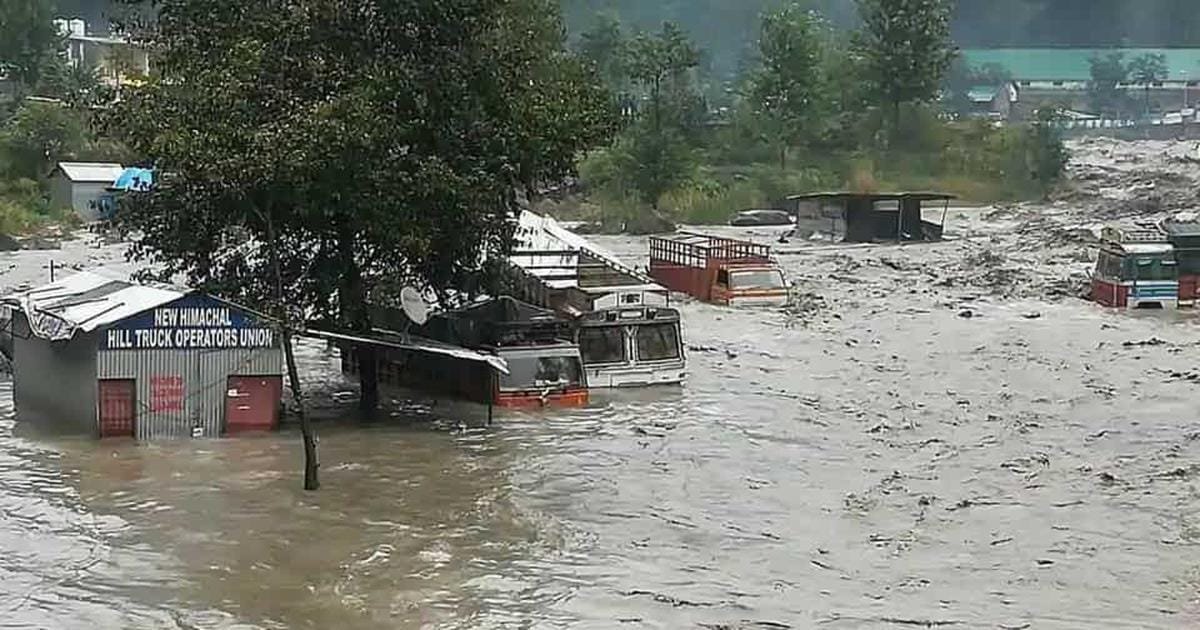On 5 August 2025, the Himalayan village of Dharali in Uttarkashi district, Uttarakhand, woke up to a disaster of historic proportions. A sudden torrent of water, boulders, and mud roared down from the mountains, demolishing homes, hotels, bridges, and shops within minutes. Witnesses described it as if “the mountain itself had melted.”
Initial reports confirmed at least five deaths, with dozens more missing. Over 40 houses and 50 hotels were swept away, and a temporary lake formed upstream in Harsil, raising fears of a secondary flood if the natural dam burst. This was no ordinary flood — meteorologists suggested it was triggered either by a cloudburst, a glacial lake outburst, or a deadly combination of both.
This incident — now known as the 2025 Uttarakhand flash flood — was not an isolated event. Across Uttarakhand and Himachal Pradesh, the 2025 monsoon unleashed repeated episodes of extreme rainfall, cloudbursts, and landslides. Hundreds of lives were lost, infrastructure worth billions was destroyed, and once again the vulnerability of the fragile Himalayas was laid bare.
The Wider 2025 Monsoon Disasters
The Dharali tragedy was only one of many episodes during the 2025 monsoon season:
Uttarakhand: Continuous heavy rains battered Dehradun, Tehri, Mussoorie, Chamoli, and Rudraprayag. Bridges collapsed, roads vanished, and landslides trapped hundreds. More than 900 people had to be rescued, while the death toll rose steadily across districts.
Himachal Pradesh: In Mandi, a cloudburst triggered flash floods and landslides, sweeping away vehicles, houses, and stretches of roads. Three lives were confirmed lost in a single night, while many remained missing.
Wider Himalayan Arc: According to reports, between June and early September 2025, more than 500 people died across Uttarakhand, Himachal Pradesh, Jammu & Kashmir, and Ladakh due to floods, landslides, and cloudbursts. Ladakh, surprisingly, recorded “large excess” rainfall, over 400% above normal, in what is normally a cold desert region.
Clearly, what unfolded in 2025 was not just a natural tragedy. It was the latest chapter in a growing pattern of climate-driven extreme rainfall amplified by Himalayan topography.
Why 2025 Was Especially Severe
The 2025 monsoon season turned particularly destructive due to a combination of climatic shifts, weather systems, and geographical vulnerabilities.
- Excess Rainfall Beyond Normal Thresholds
Uttarakhand received 24% more rainfall than the long-term average.
Himachal Pradesh and Jammu & Kashmir experienced rainfall 44–47% above normal.
Ladakh saw 434% above normal, a record-breaking anomaly for such an arid region.
- Concentrated Rain in Short Bursts
Unlike steady rainfall, 2025’s downpours often came as cloudbursts — hyper-localized rain events dropping 100 mm or more within an hour. Such bursts overwhelm natural drainage, create instant flash floods, and trigger massive landslides.
- Unusual Weather System Behavior
Low-pressure systems from the Bay of Bengal tracked unusually far north, carrying moisture deep into the Himalayas.
Western Disturbances (extra-tropical storms from the Mediterranean) overlapped with monsoon currents, intensifying rainfall events.
The Arabian Sea contributed additional moisture, partly influenced by warming ocean waters.
- Topography’s Amplifying Role
The Himalayan terrain makes any rainfall far more destructive than in the plains:
Steep slopes accelerate runoff.
Narrow valleys funnel water into destructive torrents.
Fragile geology collapses under saturation, triggering landslides.
Villages like Dharali, built near riverbanks or at valley junctions, face maximum exposure.
- Human Factors
Unregulated construction of hotels, homes, and roads on unstable slopes worsens vulnerability.
Deforestation for highways and hydropower projects reduces natural water absorption.
Hydropower dams often release excess water suddenly, magnifying flood impacts downstream.
Together, these factors made 2025’s rains among the deadliest in recent Himalayan history.
The Himalayan Topography: A Natural Recipe for Disaster
The Himalayas’ very geography sets the stage for such crises.
- Orographic Effect
The southwest monsoon winds, laden with moisture from the Arabian Sea and Bay of Bengal, slam into the Himalayan wall. As the air rises rapidly, it cools and releases moisture as intense rainfall on the windward slopes of Uttarakhand and Himachal. - Young, Unstable Mountains
The Himalayas are geologically young and still rising. Their rocks are brittle, and slopes unstable. Heavy rainfall easily triggers landslides and slope failures. - River Systems and Valleys
The Ganga, Yamuna, Beas, Sutlej, Ravi, and their tributaries originate here. Valleys act like funnels — rainfall quickly swells rivers, causing flash floods. - Cloudbursts and Localized Storms
Cloudbursts are almost unique to the Himalayas, where moisture-laden winds hit steep topography. These storms release enormous rain in a small pocket, devastating everything in their path.
Thus, even without climate change, the Himalayan topography makes Uttarakhand and Himachal inherently vulnerable. Climate change, however, has turned these vulnerabilities into ticking time bombs.
Climate Change: The Game Changer
Scientific evidence increasingly links climate change to extreme rainfall in the Himalayas.
- Warmer Atmosphere, More Moisture
A warmer atmosphere holds ~7% more water vapor per 1°C rise in temperature.
As India warms, the monsoon now carries far more moisture, leading to heavier downpours when clouds burst.
- Erratic Monsoon Patterns
Rainfall is no longer evenly spread. Instead, we see long dry spells punctuated by short, destructive cloudbursts.
- Western Disturbance-Monsoon Overlap
Climate change is altering the tracks of western disturbances.
Their overlap with monsoon currents causes prolonged, heavy rainfall events in the Himalayas.
- Glacial Retreat and Floods
Himalayan glaciers are melting faster due to warming.
Glacial lakes are growing in size, prone to sudden bursts (GLOFs) that combine with rainfall to produce catastrophic floods.
- Cyclonic Influence
Cyclones in the Arabian Sea, which are intensifying with warming oceans, push additional moisture northward, sometimes into the Himalayan belt.
The result: disasters that were once considered “rare” are now annual, sometimes even multiple times in a season.
Recent History of Extreme Events
2013 Kedarnath Floods (Uttarakhand): Torrential rain and glacial melt triggered a disaster that killed thousands.
2021 Himachal Cloudbursts: Kinnaur and Dharamshala witnessed cloudburst-induced flash floods.
2023 Monsoon Floods: Himachal saw its wettest monsoon in 50 years; roads and towns were destroyed.
2024 Monsoon: Both states issued repeated red alerts for extreme rainfall.
2025 Dharali Flood: The newest entry in a grim list of climate disasters.
Human Costs and Economic Losses
Lives Lost: Hundreds die each year, many more injured or missing.
Homes and Livelihoods: Villages washed away; farmers lose fields and orchards; tourism collapses during disasters.
Infrastructure Damage: Bridges, hydropower projects, highways, and hotels destroyed.
Psychological Toll: Residents now live in constant fear of the next cloudburst or landslide.
The Policy and Preparedness Gap
Despite recurring tragedies, policies often prioritize rapid development over ecological safety.
Char Dham Highway Project: Widely criticized for destabilizing fragile slopes.
Hydropower Expansion: Projects continue without proper cumulative impact assessments.
Urban Expansion: Hill towns like Shimla, Manali, and Mussoorie grow chaotically, with little regard for drainage or geology.
Early warning systems have improved, but remote villages still get little time to evacuate. Rescue operations remain reactive, not preventive.
The Way Forward
- Strengthen Forecasting Systems
Install more Doppler radars in the Himalayas.
Develop hyper-local rainfall prediction models.
- Eco-sensitive Development
Ban construction in landslide-prone areas.
Prioritize eco-tourism and sustainable infrastructure.
- Glacial and River Monitoring
Track glacial lakes and river flows in real time.
Prepare protocols for sudden GLOFs.
- Disaster-Resilient Infrastructure
Build bridges and roads to withstand flash floods.
Incorporate drainage systems to handle extreme rainfall.
- Community Preparedness
Train local residents in evacuation and rescue.
Strengthen village-level disaster management committees.
- Climate Adaptation Strategy
Integrate climate projections into state planning.
Align hydropower, tourism, and transport policies with resilience goals.
The Dharali flash flood of 2025 is both a tragedy and a warning. Uttarakhand and Himachal Pradesh, with their fragile Himalayan topography, will always be vulnerable to heavy rainfall. But with climate change intensifying extreme weather, the scale of disasters is escalating year after year.
If development continues unchecked — cutting forests, blasting mountains, and crowding fragile valleys — the Himalayas may face disasters of even greater magnitude in the future. The only path forward is one of climate-conscious development, scientific planning, and community-led resilience.
The Himalayas are not just India’s mountains; they are its lifeline, feeding rivers, sustaining cultures, and shaping climates. Protecting them is not optional — it is an urgent necessity.












